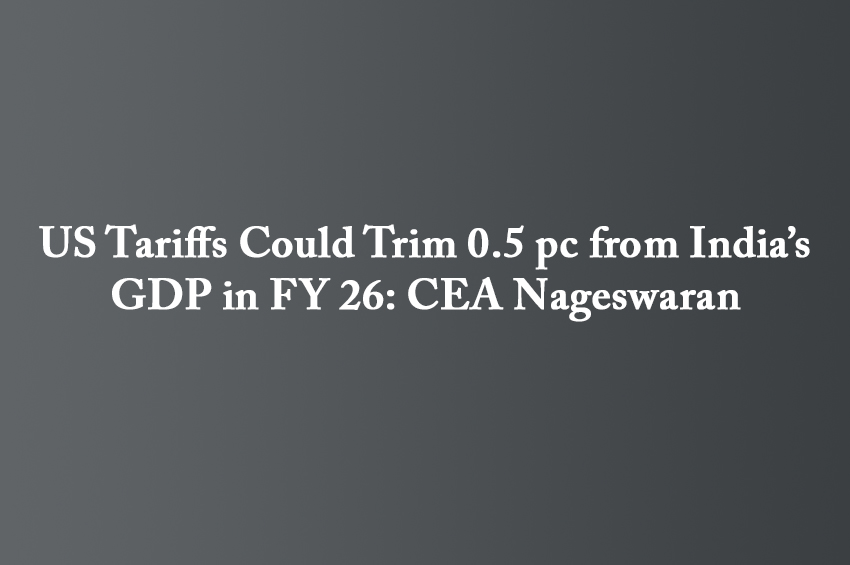Winning Bizness Economic Desk
India’s Chief Economic Advisor (CEA) Mr V Anantha Nageswaran has said that the tariffs imposed by the United States (US) on India could trim about half a per cent from the country’s GDP growth this fiscal (FY 26).
Mr Nageswaran has said that the tariffs could result in a 0.5 per cent cut in India’s GDP this financial year.
The tariffs (50 per cent) have come into effect from August 27 of this year. They could adversely affect about 55 per cent of India’s USD 87-billion exports to the United States, hitting sectors such as textiles, automobile parts, marine products, carpets, furniture and steel.
Small and medium-sized enterprises are particularly vulnerable and could be affected adversely. Here, it is important point out that these industries comprise a significant part of the country’s export base.
Despite the US-imposed tariffs, Mr Nageswaran was of the opinion that the country’s overall GDP growth forecast for FY 26 would be between 6.3 per cent and 6.8 per cent.
He pointed out that India’s strong performance in the first-quarter (Q1) of this fiscal, with the country’s GDP growing by 7.8 per cent is a clear reflection of the robust domestic demand and economic resilience.
The full impact of the tariffs is expected to be felt primarily in the second and third-quarters (Q2 and Q3) of this fiscal, the CEA said.
The point that needs to be highlighted here is that these tariffs are being viewed as an opportunity by some exporting nations such as Vietnam, Bangladesh and China.
To offset the negative effects of the tariffs, the Indian government has initiated a GST overhaul, which is an important policy measure.
Mr Nageswaran indicated that such reforms could contribute to boosting the country’s GDP by an additional 0.2 per cent to 0.3 per cent by improving cost efficiency and business competitiveness.
Consumption to be Boosted by GST Rate Cuts, says Tax Board Chairman
The GST rate cuts initiated by the government recently has the potential to considerably up consumption and this higher consumption propelled by the rate cuts could contribute healthily to off-setting the government’s revenue loss.
This was stated by Mr Sanjay Agarwal, the Chairman of the Central Board of Indirect Taxes and Customs to a leading TV news channel.
He said that the GST regime has completed eight years and now was the right time for implementing reforms. The GST regime was introduced in 2017.
“There was a thought that changes were required,” he said, adding that it was a `journey’.
On the revenue impact of the reforms, the Tax Board Chairman said that the government estimates a revenue loss of about Rs 48,000-crore based on 2023-24 fiscal data.
“It is difficult to estimate the exact revenue implications but when a rate cut happens, there is more consumption and further stimulus to GST collection,” he said.
But this will happen only if the industry passes on the benefits of the rate cuts to the end-consumer, Mr Agarwal pointed out.
The government is, however, confident that the benefits would be passed on to the end-consumer as has happened after rate cuts in the past.
Mr Agarwal said that the country’s socio-economic conditions were such that two GST rates were needed, including a lower one that addressed the needs of the people.
A standard rate such as the ones in developed countries could be implemented only when the socio-economic landscape changes, Mr Agarwal said.
EU Nod for 102 Additional Indian Marine Establishments for Exports
The European Union (EU) has approved an additional 102 marine establishments for exports.
This has the potential to result in an immediate 20 per cent boost to India’s sea-food exports to the EU.
This approval has come at a very crucial time indeed, as the EU now constitutes an important market for Indian’s sea-food exports.
The exports to the EU bloc stood at USD 1.1-billion in FY 24, clearly revealing the importance of the bloc for India’s sea-food industry.
Following the approval given to the 102 additional establishments, a total of 604 Indian establishments is now listed with the EU.
A point to note here is that this announcement comes as India and EU are engaged in the13th round of Free Trade Agreement discussions, signalling a growing confidence between the two trading partners.
A commerce ministry official told a leading news agency that the development “shows EU confidence in our standards” and reflects “significant improvement in our standards”.
“This reflects overall optimism between India and the EU”, and serves as an “important confidence-building measure”, the official added.
The EU approval is being viewed as more than just a trade facilitation measure.
“It is a big boost for Indian exports”, the commerce ministry official said, adding that “numerous meetings have been held” to resolve non-tariff measures between the two partners.
The country’s shrimp segment is specifically expected to benefit from this approval as it was among the worst affected segments by the recent US tariffs.
This approval is expected to provide the much-needed relief and alternative market access for shrimp exporters who have been seeking to diversify their export destinations.
An important point that needs highlighting here is that with all major sea-food establishments now listed for EU exports, Indian exporters will have expanded capacity to meet European demand across various marine product categories.
The European Union represents the second largest market for Indian sea-food exports after the US, followed by the Asian nations of China, Japan, Vietnam and Thailand.
Realty Firms Say GCCs Boosting Demand in Tier II and Tier III Cities
Tier II and Tier III towns in India are now increasingly witnessing an increasing number of IT Parks being established as well as Global Capability Centres (GCCs). This is propelling growth majorly in these cities, especially in the real estate sector.
Given this development, realty developers and consultancy firms are anticipating a sharp surge in demand—in both, the residential and commercial segments.
Real estate developers expect a 15-to-20 per cent annual growth in residential real estate demand across leading Tier II and Tier III cities in south India.
This growth is propelled by the emergence of IT Parks and GCCs, which, in turn, have generated jobs, thereby driving demand in both the residential and commercial real estate.
A top official of a Chennai-based realty company told a leading news publication that “demand for plotted developments is particularly strong, often delivering a 20-to-25 per cent annual price appreciation in high-demand corridors like Coimbatore’s Saravanampatti and Trichy’s Panjapur.”
Another leading developer pointed out that over 200 GCCs have already created a demand for more than Rs 30,000-crore worth of commercial real estate.
“Cities like Jaipur, Indore and Coimbatore are emerging as attractive destinations since prices are 20-to-40 per cent lower. These cities also offer better chances of retaining talent,” the developer said.
In south India, markets such as Coimbatore, Kochi, Thiruvananthapuram, Mysore and Visakhapatnam have emerged as favourites for GCCs and each location hosts more than 20 such centres.
Both Coimbatore and Mysore offer tremendous advantages—the former offers a 25-to-30 per cent cost advantage as compared to other cities while Mysore’s advantage is its proximity to Bangalore, the IT capital of India.
An important point to highlight here is that these locations also have ready Grade A office spaces, SEZ benefits, lower land costs and strong infrastructure. Additionally, there is metro connectivity as well.
The entry of IT Parks and GCCs have positioned Tier II and Tier III cities as new growth engines for real estate. That these locations benefit from improved connectivity, cost arbitrage and a large skilled manpower pool is another point that needs highlighting.
Policy support from state governments is strongly driving the growth of GCCs and consequently, the growth of these cities and towns.
Under its `Beyond Bengaluru’ initiative, the Karnataka government has set a target of establishing 500 new GCCs between 2024 and 2029.
Similarly, in Telangana and Andhra Pradesh, GCCs are expected to buy 35-to-37-milion sq ft of office space over the next three years.
Thus, the rise of GCCs is expected to propel real estate’s growth in Tier II and Tier III cities going forward.


